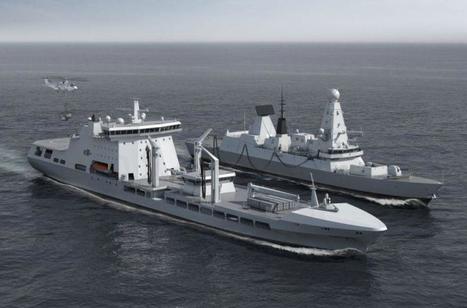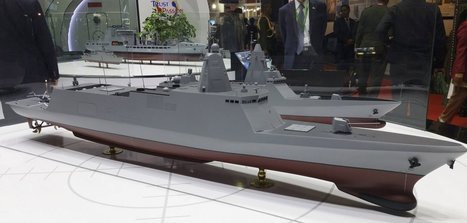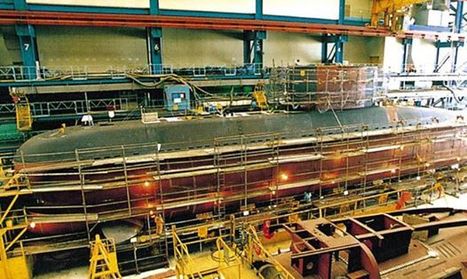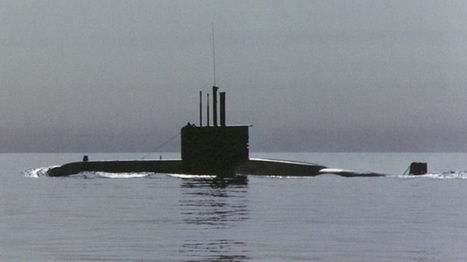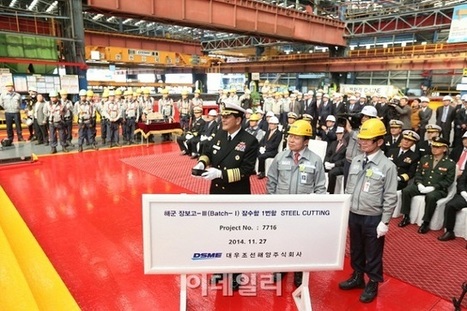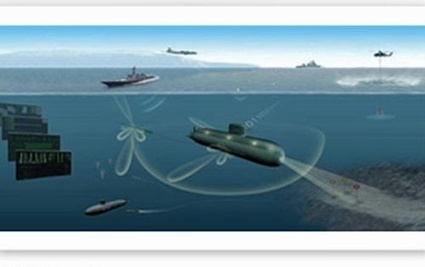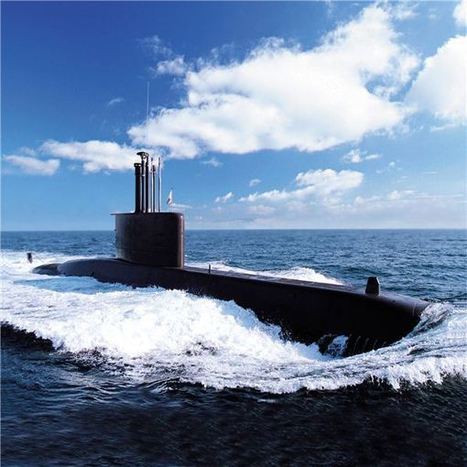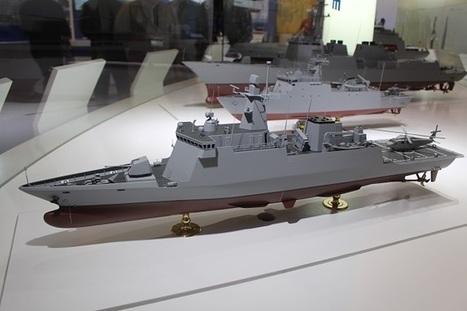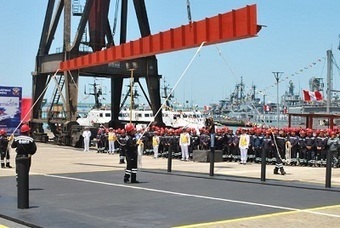 Your new post is loading...

|
Scooped by
Patrick H.
|
La construction du premier des quatre nouveaux bâtiments logistiques de la marine britannique est en cours au chantier Daewoo Shipbuilding & Marine Engineering d’Okpo, en Corée du sud. Après la découpe de la première tôle, l’été dernier, la construction du Tidespring doit prendre 10 mois, son achèvement étant prévu au mois d’octobre. Ses sisterships, les Tiderace, Tidesurge et Tideforce doivent ensuite suivre à six mois d’intervalles, soit des livraisons programmées en avril 2016, octobre 2016 et avril 2017. Construits sur la base du design Aegir, développé par le groupe britannique BMT Defense Services, ces ravitailleurs mesureront 209 mètres de long et présenteront un déplacement de 37.000 tonnes en charge. Dotés d’une double coque et capables d’atteindre la vitesse de 20 nœuds, ils seront armés par la Royal Fleet Auxiliary, avec un équipage de 63 marins et une capacité d’accueil pour 46 personnes supplémentaires. On notera que les bâtiments ne seront pas bons pour le service au moment de leur livraison par DSME. Les plateformes, propulsées et aménagées, rejoindront d’abord un chantier britannique qui assurera leur achèvement et l’intégration des différents équipements, dont les matériels sensibles, comme au niveau de l’électronique des communications et de l’armement. C’est le chantier A&P de Falmouth qui a été retenu par la RFA. Lire l'intégralité de l'article sur Mer et Marine : http://www.meretmarine.com/fr/content/les-nouveaux-ravitailleurs-britanniques-en-construction

|
Scooped by
Patrick H.
|
Key Points - DSME has revealed details of the proposed weapons fit for South Korea's KDDX destroyer programme
- The proposed platform could potentially launch a new variant of South Korea's Haeseong anti-ship missile
Daewoo Shipbuilding & Marine Engineering (DSME) revealed further details of its proposal for the Republic of Korea Navy's (RoKN's) KDDX destroyer programme at the Indodefence 2014 exhibition in Jakarta. The platform, known as the DSME 8000, is being touted as a cost-effective solution to the RoKN's search for a class that can fill the gap between the KDX-2 destroyers and the larger KDX-III Aegis ships. "Think of the DSME 8000 as a cheaper version of the Aegis ships, but with almost all of the class's functionalities", said Jae Do Na, an assistant engineer from DSME's naval and special ship design team. Source Navy Recognition : http://www.navyrecognition.com/index.php?option=com_content&task=view&id=2160 Based on the model (and confirmed by two DSME representatives at Indo Defence), the KDDX will be fitted with 16x SSM-700K Haeseong (C-Star) Anti-ship Missile launchers, 48x vertical launch systems at the bow (MK41 from Lockheed Martin or some Korean VLS under development by Doosan) for surface to air missiles, 16x larger K-VLS back aft. This could not be confirmed at Indo Defence, but Navy Recognition believes these larger K-VLS will be used to store and launch LIG Nex1's Hyunmoo-3C land attack cruise missiles with a range of about 1,500 km. There are speculations in South Korea that there will also be an anti-ship version of the Hyunmoo missile. A Phalanx CIWS is fitted on top of the dual helicopter hangar.
For anti-submarine warfare, the class is expected to be fitted with bow and towed array sonars, and with torpedo launcher as well as K-ASROC (for Anti-Submarine ROCket).
KDDX will be fitted with Lockheed Martin's AEGIS SPY-1 radar or some equivalent, possibly a similar AESA phased array radar from Samsung-Thales, on an integrated mast to reduce radar cross section. KDDX will have a crew of about 180 sailors. We were told the propulsion system will be CODAG (Combined Diesel and Gas) but that many of the subsystems and peripheral equipment will be selected at a much later date.
Displacement of the class is set to be about 8,000 tons, length 155 meters, breadth 18.8 meters and draft 9.5 meters.

|
Scooped by
Patrick H.
|
Indonesian shipbuilder PT PAL is sending additional personnel to South Korea's Daewoo Shipbuilding & Marine Engineering (DSME) to undergo training in submarine construction, it was announced on 17 October. The training is part of the industrial collaboration programme linked to Indonesia's order in late 2011 of three DSME Chang Bogo-class Type 209/1200 submarines. This programme outlines DSME's construction of the first two submarines with gradually increased input from PT PAL personnel, leading to the Indonesian company's licenced-build of the third boat at its facilities in Surabaya. PT PAL said in a statement that 160 personnel will travel to South Korea over the next few months and will join other PT PAL engineers and technicians already seconded to DSME.

|
Scooped by
Patrick H.
|
06/06/2014 (Infodefensa.com) GSF, Madrid - Australian Defence Minister, David Johnston , announced today its decision that the contract to build two new supply vessels for Navy attend only two competitors: the Spanish Navantia and South Korea's Daewoo . Industry sources have told Infodefensa.com in this case, despite the tough competition that always involve Korean, Spanish option has the best chance. Korean jobs have materialized, do not meet the requirements of the RAN ( Royal Navy of Australia ), as if the Spanish company, which also have a strong presence in Australia, for which they built ships and makes LHD and where he was recently operating the Combat Supply Ship (BAC) Cantabria to meet Australian needs precisely supply operations and, incidentally, to familiarize sailors with a similar vessel to which you might end up ordering now. "The competition between these two experienced Yards is the best way to ensure the delivery of the vessels at a good price and in the time frame required," said Johnston, who thus left out of the process to Australian shipyards to which this week has drawn attention for its low productivity on the agenda of anti-aircraft destroyers AWD , which are built in the country based on a Spanish frigate design F100 Navantia. The minister has chosen this time by commissioning the construction, and not only the design, as with these destroyers, to foreign companies, so that investment more profitable (the program of the AWD , estimated at about 6,200 million euros, has already increased in price by 220 million and drag a delay of two years). This measure is the Australian Government to meet the "urgent need for large support vessels we evaluated that are beyond the capacity of Australia to produce competitively at this stage." Problems with local shipyards Continuing problems in Australian shipyards could also end up being manufactured abroad eight frigates tender is expected later, though Johnston has stated that his intention is that this fleet, for which design and has been allocated $ 78.3 million , whether manufactured in the country. The minister, in any case, has warned that this commission could also end up overseas if the local industry is not back his flight: "No responsible government could consider continuing to work for an industry that is functioning so poorly," he pointed . The decision to go with Navantia and Daewoo as only competing for bids to replace HMAS Success and HMAS Sirius has raised strong domestic criticism in Australia, where the union workers AMWU has denounced the decision to offshore Australian shipbuilding. At the same time, the union has welcomed the announced government's decision to build in the country twenty new patrol the Pacific class. In a statement released today by the Ministry of Defence of Australia, Johnston has warned to "shipowners and unions understand that shipbuilding in Australia is at a critical crossroads," which has led him to take this step. For its part, the opposition leader, Bill Shorten , has accused the government of "torpedo" thousands of jobs in the defense industry in Australia by this decision which he described as "reckless" to put the defense capabilities and construction naval country "at risk for the future." Spain's experience serving the RAN The chances of Navantia to win the business of the two future supply ships in combat are very high, because it is a customer with a great fondness for the products of this company, has acquired two LHD -like strategic projection ship Juan Carlos I Spanish and layout of the destroyers and AWD based on the F100 , among others, and is very familiar with what kind of ship you are eligible for this contest Spain. In fact, last year the BAC Cantabria completed the Marina Australian 79,000 miles (equivalent to twice around the earth) for 215 days at sea. Throughout that time made more than fifty maneuvers RAS and 150 aircraft operations, all with Australian crew, which allows the RAN get to know what kind of ship would have if his government finally opts for the Spanish product .

|
Scooped by
Patrick H.
|
State-owned shipbuilder PT PAL will complete an indigenously-built Chang Bogo-class diesel-electric submarine (SSK) by 2018, Indonesia's Defence Industrial Policy Committee (KKIP) said on 19 February. The KKIP, established in October 2010 to formalise national policies on defence procurement and indigenous manufacturing, was responding to discussion of the Indonesian government's decision to invest a further USD250 million in the local shipbuilder. PT PAL was allocated the funding to enable it to modernise its facilities in order to construct and support submarines. Indonesia's first and second Chang Bogo-class SSKs, scheduled to be delivered by 2017, are currently being constructed by Daewoo Shipbuilding & Marine Engineering (DSME) with gradually increased input from PT PAL engineers and technicians. The third SSK will be license-built in a PT PAL shipyard in Indonesia. To date, the KKIP has sent 206 personnel to South Korea to work with DSME. Admiral Purnawirawan Sumardjono, head of the KKIP, said that the bigger picture behind these arrangements is for Indonesia to develop the capacity to operate 12 submarines. "We have 5 million km 2 of water to patrol. At this point in time, we only have two [boats]", said Adm Sumardjono. The Indonesian Navy (TNI-AL) currently operates two German-built Cakra Type 209/1300 submarines, built in the 1970s. The admiral added that Indonesia ultimately plans to move away from imports as a means of fulfilling its defence requirements, including in the underwater domain. "If we are embargoed, we are finished", he said. "A country that takes charge of its own needs via an indigenous defence industry can have its say in world politics". COMMENT Given Indonesia's current level of local experience in building submarines, the build timeline set out by the KKIP seems optimistic. No concerted work appears to be underway as yet on the infrastructure upgrade, and reports suggest only a small proportion of the industrial workforce has been sent for training in South Korea. Moreover, building a boat of this size can take 4-5 years when supported by an established knowledge base and production line. Taking these steps into account, it may be more likely that a boat assembled locally (following material build elsewhere) could be ready by 2020, with a locally built boat ready in 2022. Alex Pape , Principal Analyst, Naval Ship/Sonar Programmes, Jane's Defence Procurement/DS Forecast

|
Scooped by
Patrick H.
|
State-owned shipbuilder PT PAL Indonesia will get up to US$250 million in state capital injection (PMN) under a multi-year project for the development of submarines to support the nation’s defense system.
Of that amount, $180 million will be channeled this year, according to Deputy Finance Minister Bambang Brodjonegoro at a hearing with lawmakers at the House of Representatives on Monday.
Bambang added that out of the $250 million given to PAL, $150 would be used for the construction of the shipyard, $30 million for “consultation” and that $70 million would be spent on personnel, such as experts and technicians.
The PMN will be included in the revised state budget (APBN-P) for 2014 and the State-Owned Enterprises (BUMN) Ministry will oversee the matter.
To develop the submarines, PAL will work with South Korean shipbuilder Daewoo Shipbuilding and Marine Engineering (DSME).
Based on the contract between DSME and the Indonesian Defense Ministry in 2011, PAL’s shipyard must be completed and ready by November 2014.
The contract also states that the first two submarines will be built completely at a DSME plant in South Korea and that the third submarine will be built completely by PAL in Indonesia through the transfer of technology and knowledge.
Although the project is already running behind schedule, Navy chief of staff Adm. Marsetio claimed that the submarines built at the DSME plant were expected to be completed by 2017, while the one to be built by PAL was predicted to be completed by 2019 or 2020. “The facilities needed for construction must be ready by November. Therefore, due to the time limit, the budget must be submitted [to the House] by April or May at the latest,” said House Commission on defense, foreign affairs and intelligence lawmaker Tubagus Hasanuddin at the hearing... ...Aside from building capable shipyards, Indonesia must also send 206 technicians and experts to DSME as part of the technology transfer set out in the contract. However, as of February, PAL has only sent 13 people.
|

|
Scooped by
Patrick H.
|
Under the Jangbogo III programme, the first submarine is due to be launched in 2018 and handed over to the Republic of Korea Navy at the end of 2020 following two years of sea trials. The second submarine will be delivered at the end of 2022. KSS-III is expected to be produced in three batches:
Batch-I consists in the first two hulls to be built by DSME.
Batch-II will consist in three hulls built by HHI (Huyndai Heavy Industries). They will be fitted with a greater deal of South Korean technology.
Batch-III will consists in the four remaining hulls (for a total of nine KSS-III submarines across all batches). The last submarine is expected to be delivered in 2029.
The original design of the submarine includes 6x VLS (vertical launch system) tubes. They would accomodate a future cruise missile in development by LIG Nex1 while the launchers would be provided by Doosan. It was announced earlier this year that Spanish company INDRA was selected to provide its electronic defense system (ESM) PEGASO and Babcock of the UK would design and manufacture the Weapon Handling System for the Batch-I submarine.
It was officialy announced during Euronaval 2014 that Sagem would supply the optronic masts for the class. Navy Recogition learned in september from a source that Thales would supply sonar systems for the class. However it appears that flank array sonars will actually be provided by Korean company LIG Nex1. LIG will also supply KSS-III's combat management system. The submarine will be fitted with south korean lithium-ion battery technology. Detailed specifications of KSS-III (Jangbogo 3) Batch-I:
Full-length 83.5m
Beam 9.6m
Pressure sensor diameter 7.7m
Draught 7.62m
Crew: 50 sailors
M aximum speed: 20 knots
Cruising range" 10,000 nm
Surface tonnage: 3358 tons
Submerged tonnage: 3705 tons

|
Scooped by
Patrick H.
|
Euronaval 2014 Paris October, 27 2014 - Following an international request for proposals, Sagem (Safran) has signed a contract with Daewoo Shipbuilding & Marine Engineering Co. Ltd (DSME) of South Korea, to supply the optronic surveillance masts for the country’s new submarines.
The selection of Sagem was made by a commission comprising members from the South Korean navy, DAPA (Defense Acquisition Program Administration), ADD (Agency for Defense Development) and DSME. The decisive factors in this decision were the best world-class competitiveness and performance level offered by Sagem’s optronic masts, especially in terms of image resolution and processing, and their easy integration in the ship’s combat suite.
This latest contract emphasizes the outstanding collaboration between South Korean industry and Sagem. Sagem’s new generation of optronic masts, which do not penetrate the thick hull, feature low-observability and radar stealth. In addition to the optronic (electro-optical) sensors from Sagem, they also include a signal intelligence system, and an infrared system for discreet communications.
The future optronic surveillance mast is derived from Sagem’s Series 30 masts already in production for the Scorpène class submarines built by French naval shipyard DCNS for international markets, and for the future Suffren class nuclear attack submarines in the French navy’s Barracuda program.
Sagem develops and produces for its partners a complete family of optronic masts and attack periscopes, electronic warfare equipment and radars for submarines.
The masts will be integrated at Sagem’s plant in Dijon and the infrared imagers in Poitiers.

|
Scooped by
Patrick H.
|
SEOUL, Sep. 30 (Korea Bizwire) — It is likely the next-generation submarine for the Republic of Korea Navy will be Jangbogo III (Batch I) based on homegrown technology. The Defense Acquisition Program Administration said on September 29 that Daewoo Shipbuilding & Marine Engineering, the shipbuilder to assemble two 3,000-ton class conventional submarines, has sufficient capabilities to build such ships in a critical design review sessions held for five days between September 25 and 29 with 150 experts from the navy, industry, and academia. The 3,000-ton Jangbogo III is Korea’s first submarine built with proprietary technology. The Defense Acquisition Program Administration had signed a design and assembly agreement with Daewoo Shipbuilding on December 24, 2012. Currently the detailed design stage is under way. In the latest meeting, experts discussed in-depth reviews on five areas including operational performance, special performance, test evaluation, and the like and concluded that the design blueprint of the Jangbogo III has reached a completion stage. Shin Jeong-ho, brigadier general and the head of DAPA’s naval shipbuilding unit, said, “The Jangbogo III will be Korea’s first ship applied with systems engineering. The recent critical design review session proved that Korea has enough submarine building capacity comparable to that of major industrialized countries in the world.”

|
Scooped by
Patrick H.
|
At DSA 2014, the 14th Defence Services Asia Exhibition and Conference currently held in Kuala Lumpur (Malaysia), Korean shipbuilder DSME introduces for the first time its Missile Surface Corvette (MSC). Navy Recognition learned during DSA 2014 that DSME teamed with a local partner to answer an RFI from the Royal Malaysian Navy for a small displacement corvette. The MSC model shown at DSA 2014 is fitted with a 76mm Oto Melara main gun, 4x Kongsberg NSM anti-ship missiles, 2x MSI 30mm guns located aft, and several South Korean made sensors, most of them from Samsung Thales.
DSME representatives at the trade show stressed however that configuration is just a suggestion and that they are ready to adapt according to customer requirements. DSME's MSC has a length of about 85.5 meters, a breadth of 12.9 meters, a draft of 3.8 meters for a displacement of about 1,800 tons.
The MSC crew consists of 60 sailors. Its top speed is 26 knots and endurance in excess of 20 days. DSME is also showing at DSA the DW3000 Frigate selected by the Royal Thai Navy. Thailand recently ordered two units of this class of ship from DSME to be delivered in 2018 and 2020. The displacement is about 3,700 tons.

|
Scooped by
Patrick H.
|
(Infodefensa.com) Lima - The state shipyard SIMA Peru has initiated the construction program of ten patrol of approximately 500 tons displacement, with the keel laying of the first unit. The corresponding symbolic ceremony was held in the premises of the industrial plant of Callao. Attending the ceremony, President, Ollanta Humala , the Minister of Defence , Peter Cateriano , senior naval officers and the shipyard itself. With an estimated investment of 250 million dollars, the Navy of Peru ( MGP ) implements the construction of ten patrol through an agreement with the institution of military procurement Korea ( DAPA , for its acronym in English) and the yard of the same origin, STX Offshore & Shipbuilding , who has contracted with a first batch of five units. The selected platform won, among others, a pattern also Korean Daewoo Shipbuilding & Marine Engineering ( DSME ). DAPA assigned industrial projects usually originate in a shipyard to other companies in the shipbuilding industrial base of China. The class Gumdoksuri, oriented alternately armed patrol and manufactured by Hanjin Heavy Industries and STX, and class Taegeuk , oriented maritime police and manufactured by DSME but whose proposal to the MGP would have been assigned to STX, share a common origin. No official before the tender, the intention of the Navy patrol obtain easily convertible into units with heavier armament and associated sensors speculated. The ten patrol vessels will be built at the shipyard SIMA Chimbote .
Upgrade SIMA During the ceremony the construction of a salvage tug for MGP was also launched with an investment allocated ten million dollars and will be manufactured at the plant SIMA Callao . Moreover, the Peruvian government has launched a program of modernization of the Navy Industrial Services ( SIMA ) with three units in Callao, Chimbote, Iquitos, by investing 220 million soles ($ 78.5 million) . According to President Humala, is probably the construction of two additional manufacturing plants, one located in the department of Puno (with the important lake via Lake Titicaca ) and the town of Saramiriza in the jungle Loreto .
|



 Your new post is loading...
Your new post is loading...

